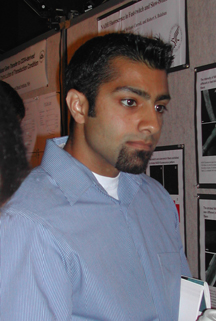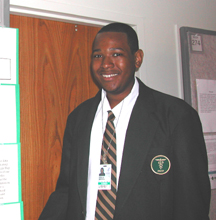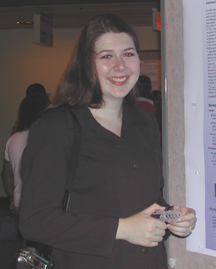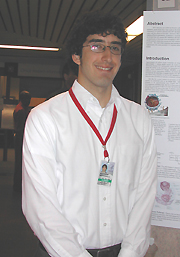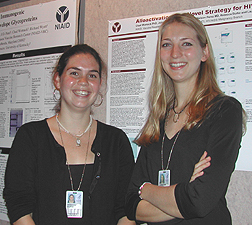 |
|
Double
Take: Rebecca Burke (left) and Christina Nelson Perez
|
Inhibiting HIV with Alloimmunized Lymphocyte
Rebecca Burke, Brown University, Providence, R.I., and Christina Nelson Perez, Case Western Reserve University School of Medicine, Cleveland. Alloimmunization as a Strategy for HIV Therapy
Preceptors: Chad Womack, Viral Pathogenesis Laboratory, NIAID-VRC, and Lauren Wood, HIV & AIDS Malignancy Branch, NCI
Previous work by NCI’s Gene Shearer demonstrated that stimulation by foreign lymphocytes generates an alloresponse in ordinary lymphocytes that results in their ability to inhibit HIV replication in vitro.
The current study—comprising three experiments—seeks to characterize the alloresponse and identify the source of anti-HIV activity.
First, the team isolated CD8+ T-cells and stimulated them with foreign B-cells to establish whether the activated CD8 cells would inhibit HIV replication in the presence of HIV+ CD4 cells. This experiment, Nelson Perez noted, proved inconclusive because both the experimental and the control cultures came back negative for HIV.
The second experiment examined the surface markers of the CD8 cells before and after alloactivation. FACS analysis showed that CD27 and, to a lesser extent, CD45RA increased post-alloactivation, while CCR7 and HLA-DR decreased.
The third experiment, soon to be undertaken, will expose HIV-infected cells to each of these CD8 subpopulations separately to see to what extent each factor contributes to HIV inhibition
The ability eventually to identify correlates of alloimmunity with CD8 T-cell effector function may lead to the design of immunotherapies for transplant, cancer, and HIV patients.
Nelson Perez, who just graduated from medical school, says she’s been "bitten by the HIV research bug." She’s interested in pediatrics and public health. Burke, now applying to medical school, is drawn to pediatrics.
